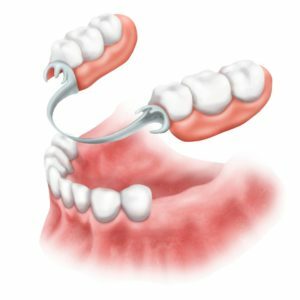 Prosthetic dentistry is often a compulsory and necessary method of treatment, but modern medicine has gone so far ahead that there is plenty of room for such an event.
Prosthetic dentistry is often a compulsory and necessary method of treatment, but modern medicine has gone so far ahead that there is plenty of room for such an event.
You can choose exactly the method of prosthetics, which more closely corresponds to the need, while the aesthetic appeal will remain at a high level.
Conditionally prosthetic devices can be divided into two groups:
- non-removable;
- removable.
Each species has both advantages and disadvantages, not in every case they are applicable.
Contents
- We put once and for all
- Insert teeth - clutch, clutch, clutch
- Materials for prosthetics
- Thoughts of ordinary people
- From questions to dentist
We put once and for all
What are non-removable dentures? For example, with the help of a crown it is possible to restore the tooth even when it is fractured by almost half. To put this prosthesis, it is enough to have a strong healthy root. Crowns are used in the presence of a threat to the health and preservation of the tooth, as well as to improve its appearance.
The prosthesis is fixed to the rest with dental cement. Crowns are made from a wide range of materials, this varies the price and the length of their service.
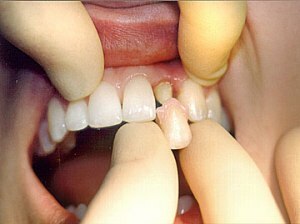
In the photo installation of the crown
The pros of this type of prosthesis include:
- a wide variety of materials;
- is relatively inexpensive;
- long service life;
- positive result.
This method, however, has a significant drawback, in particular, the need for grinding the tooth with grinding to 2.5 mm and its depulpation.
The process requires disruption of the integrity of the surface tissue, which is undesirable in the case of a healthy tooth.
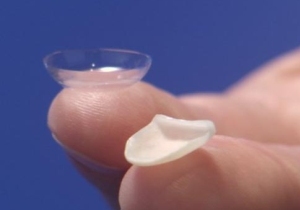
Lumineers - modern and beautiful
For aesthetic purposes, veneers are used to restore the teeth of the front row. They are mini-prostheses that are worn over the front of the tooth. This requires turning the surface to 1 mm.
There is a more perfect version, called lumineers, not accompanied by turning. The prosthesis is so thin that when attached to the top of the tooth it does not seem unnatural.
The advantage of this type of prosthesis is the high degree of attractiveness of a smile, but this method is not able to cope with serious tooth damage.
A prosthesis can cover only one part of the tooth, while the inner zone must be healthy. The main disadvantages of the method are a short service life, as well as a high cost.
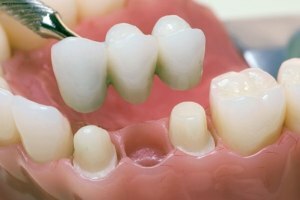
Bridge with self-supporting teeth
Bridges are a prosthesis consisting of several cast-type crowns. This method helps to hide the absence of one or more teeth. To install the bridge, at least two supporting teeth are required, in the absence of a bridge, implants are used.
The bridge resembles a dentition that covers missing areas and is fixed at the edges. There is a huge variety of materials for this prosthesis, so it can simulate a dentition similar to natural.
The method has many positive characteristics. These include:
- aesthetics of the dentition;
- is relatively affordable;
- comfortable toe and easy care.
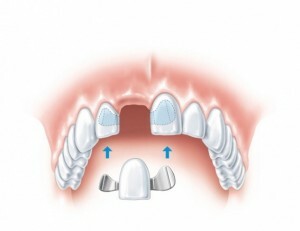
Adhesive bridge
Prosthetic bridges are only allowed on absolutely healthy teeth, and it does not exclude the need for grinding while supporting them.
In this connection, due to excessive loading with time, teeth can become mobile. The lack of pressure under the middle part of the bridge often leads to bone atrophy.
An alternative is an adhesive prosthesis, which in its essence resembles a bridge, but the fixation is fixed not on the pinned support, but with the help of a metal frame to the adjacent teeth.
This method is able to keep teeth from depulpation, but there is a risk of carious lesions. In addition, the design is short-lived, and it is not installed on the chewing teeth.
Implants 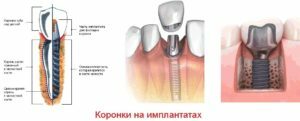 can be called the most expensive method of prosthetics, but it is the most durable. With the right approach to the choice of treatment, as well as following all the recommendations of the dentist, you can get a strong artificial root, which then will not need to be changed.
can be called the most expensive method of prosthetics, but it is the most durable. With the right approach to the choice of treatment, as well as following all the recommendations of the dentist, you can get a strong artificial root, which then will not need to be changed.
The implant pin is a solid base for the bridge or crown, which does not require the grinding of adjacent teeth. This method is reliable, but has many limitations.
In addition, there is a risk of rejection of a foreign body, as a result of which the surgical procedure will have to be repeated.
Insertable teeth - clutch, clutch, clutch
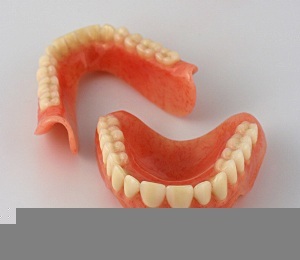
Removable plate prosthesis
Which teeth are better to insert? This question is asked by patients who have a significant defect in the dentition and who want to know more about the modern possibilities of dentistry.
Removable dentures have their own characteristics, and a large group of consumers prefer them. Often there are plate prostheses, which are a gum site and dental crowns that cover the missing areas of the teeth.
Plates are full-length or partially-removable, which are installed on a certain area.
For partially removable prostheses, a prerequisite is the presence of at least a few healthy teeth, on which the design will be installed. The support for completely removable plate prostheses are the gums or the palate.
Fastening occurs due to suction properties, often requires additional use of fixing creams. Such designs are often called prostheses on suckers.
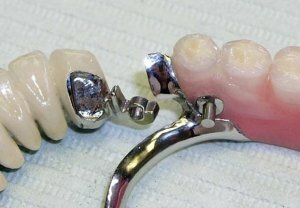
Lock attachment
This method of prosthetics, depending on the material, is different in price. Basically, removable structures require careful care, since after eating food under them can accumulate the remains of food.
It is not always easy to get used to such prostheses, diction, taste sensations are often violated.
There are also conditionally removable bridges that are easy to remove and fasten independently, without assistance. Fastening is carried out with the help of special locks, which are installed on adjacent teeth, and they do not need to grind.
This kind of prosthetics is fixed not only on healthy teeth, but also on implants and crowns, and this is the main advantage of the design. In general, this method has no significant drawbacks.
Materials for prosthetics
Materials may vary depending on the type of prosthesis. So, for non-removable prostheses the main raw materials are:
-
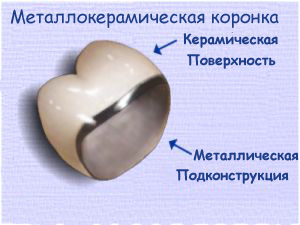 metal;
metal; - ceramics;
- plastic.
In dentistry, the aforementioned materials are often combined to achieve the desired effect. Metal is considered the most reliable and durable, but it does not possess the aesthetic qualities that are characteristic of ceramics.
In this regard, the most preferable option will be a cermet prosthesis, which has a steel frame and an exterior design of zirconium oxide.
The prosthesis is distinguished by its high strength and aesthetics, but its price is much higher than that of its analogues. Plastic and metal-plastic crowns are inexpensive, but they can last no longer than two or three years. In addition, the artificial material is subject to external factors.
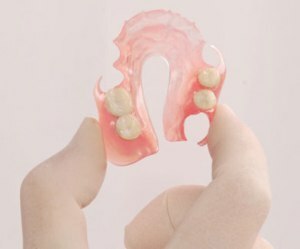
Prosthesis Acry Free
Other materials are used to make removable prostheses:
- acrylic;
- Acri Free;
- nylon;
- acetal polyurethane;
- clasp designs.
Acrylic constructions are exposed to external influences due to their nature. The material loses its original appearance, eventually acquires a specific smell and color.
Adapting to it for a long time, the prosthesis often falls off during the meal because of the rigidity of the base.
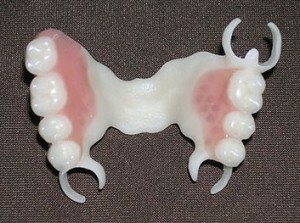
Acetal denture
The new technique in the manufacture of removable structures is Acri Free. The base for fastening is made of acrylic translucent resins, imperceptible on the gums. The material is flexible, so the service life of the equipment is high.
The only drawback of such prosthetics is the high cost of manufacture, which is not inherent in other materials of removable structures.
Nylon and acetal dentures in their properties are close to the technology of Acry Free. They do not rub the gums and are well attached, the service life is quite long, and the aesthetic appearance corresponds to a high level.
However, this material also has its drawbacks:
-
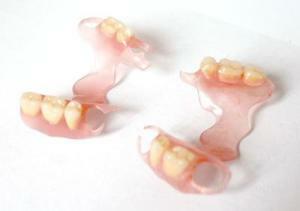
Nylon construction
incorrect distribution of the load on the jaw;
- rejection of coloring food and beverages;
- risk of subsidence after a short period of time;
- impossibility of chewing solid food;
- cleaning is performed by special means;
- high cost.
Clasp prosthetics can be called the most perfect way for a removable type. The design is made with an orientation to the characteristics of the patient, the load is distributed evenly over the jaw.
Aesthetic view of the structure at height, but also the price of clasp dentures corresponding. Nevertheless, this method is one of the most durable for removable dentures.
The only drawback is the long production time. It is necessary to visit the dentist more than once, so that he adjusts the design up to a millimeter.
Thoughts of ordinary people
Prosthetics have become so popular that many people have fixed designs that others do not even guess at. The patient's feedback only contributes to making the right decision in favor of various prostheses: removable and permanent.
For a long time I suffered with a tooth, the seal did not hold at all. Only put, within a week began to collapse, then significant pieces fell off, a couple of months again went to the dentist. After a couple of replacements, the dentist offered to put the crown, from his tooth and so little is left, and such frequent sealing can ruin completely.
The procedure for cutting the tooth was painless, the crown was ready very quickly. I thought that it would be unusual with cermets, but on the whole I do not see a tangible difference. I have been happy for a year already, I do not know the problems. According to the dentist, I also go through ten without problems.
Oksana, Smolensk
The front teeth are quite shaky, the pair has already lost completely, but there are some porridges and mashed potatoes do not really want. When I went to treat a tooth, the dentist suggested a bridge structure, which not only can strengthen teeth, but also looks attractive. To me, of course, the appearance is not particularly important, but the opportunity to eat apples is what you need. I had to wait about a month, but now I have a stable prosthesis, which is pleasant to look at.
Victor Ivanovich, Samara
I have terrible teeth, in front a row uneven, and even yellowness expressed me always embarrassed. It was too late to fix anything, and there was no desire for it, and the friend put a veneer for herself. After consulting the dentist, I came to the conclusion that this is the right solution. Now I go with a beautiful smile, self-esteem has increased several times.
Olga Sergeevna, Moscow
I did not dare to have permanent prostheses, and I need so much money. The doctor offered to try to start the removable plate. I have been with them for several months, everything suits me. However, all the same comes the realization that the permanent will be even better.
Christina, Ryazan
From questions to the dentist
What to do with a complete absence of teeth?
With the complete absence of teeth 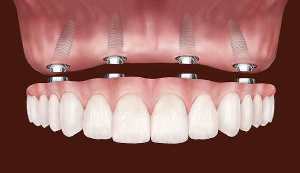 , the only option is complete removable prosthetics. Plates are attached to the gums and the hard palate. The patient can choose the most suitable option as a material, the more perfect is Acri Free.
, the only option is complete removable prosthetics. Plates are attached to the gums and the hard palate. The patient can choose the most suitable option as a material, the more perfect is Acri Free.
Because of the difficult fixation on the lower jaw, in the absence of teeth, it is often recommended to resort to implants, to which other types of prostheses are easier to fix. This will ensure the reliability of the design, facilitate the process of chewing food.
What is the best temporary prosthesis for the front teeth?
It is better to install a temporary crown on the front teeth, without necessarily choosing expensive material. Many dentists propose to do with polymer prostheses, which are quickly manufactured and have a pleasant appearance, but an insignificant service life.
Especially this type of prosthesis is good after the implant installation, since for a better effect, it is necessary to load the pin and the surrounding gum. The crown will perform this function, and when installing a permanent prosthesis, an undesirable reaction will not follow.

In the picture, the
upper cutter adhesive prosthesis Another option is an adhesive bridge that fills an empty space with an imitation of a natural tooth. The huge advantage of this method is that adjacent teeth are not subjected to significant interference. In some cases, minor depressions may be required, but they can be done by increasing the filling, which is subsequently polished.
As a temporary prosthesis, in no case should it be possible to install removable dentures with fastening to the gums on the Velcro, as over time the fabric is deformed. As a result, you may need plastic before installing a permanent prosthesis regardless of its type. This will complicate the process and increase the cost of the procedure.
What prostheses should I put on?
 The choice of prostheses should, first of all, rely on the need to return the main function of the organ - chewing. For many, along with it, the aesthetic component is important.
The choice of prostheses should, first of all, rely on the need to return the main function of the organ - chewing. For many, along with it, the aesthetic component is important.
There is no patient who is not interested in the price issue. All these factors should be taken into account, and only the dentist will help to choose the most suitable option in accordance with the characteristics of the patient.
Depending on how many teeth are missing and what the general extent of damage to surrounding people can be preferred in favor of non-removable prosthetics, such as crowns or bridges. Fixed prosthetics do not require special care.
To restore aesthetic appeal, veneers are usually installed, but if there are problems with the chewing function, preference is best given to more stable options, for example, implants.
What are the types of dentures and how to choose the right one for you will tell a dentist:
